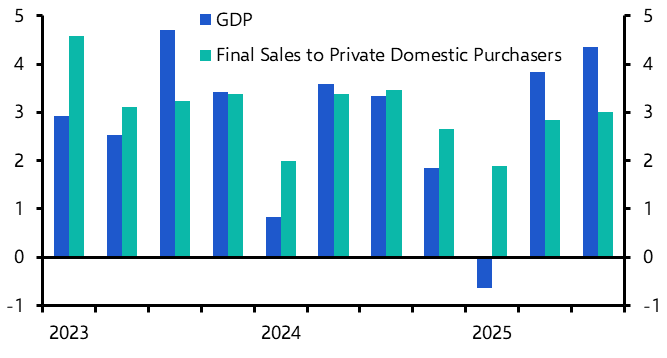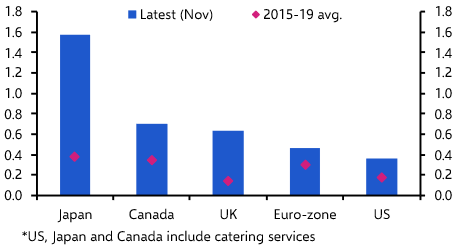Neil Shearing
Group Chief Economist
I had intended to write this week’s note on lags in monetary policy – then SVB blew up, Signature Bank followed in quick succession, and US policymakers were forced to introduce a package of emergency measures over the weekend. The two issues are, in fact, related, which I’ll come back to. But first a few words about SVB and the broader health of the global banking system.
The first point to stress is that problems at the California lender do not seem to be shared among larger banks in the US. SVB’s deposit base appears to have been drawn heavily from the tech sector, with a high proportion of deposits in excess of the $250k threshold guaranteed by the Federal deposit insurance scheme. Meanwhile, on the other side of its balance sheet, an unusually large proportion of assets were held in fixed income securities rather than loans.
This proved to be a toxic mix. Problems in the tech sector led to a withdrawal of deposits, forcing SVB to sell securities. Crucially, once these assets were moved from SVB’s banking book to its trading book it was forced to mark them to market, thereby realising losses caused by the aggressive rise in interest rates over the past year. (Higher interest rates means lower bond prices.) These losses ultimately led to SVB becoming insolvent.
Stepping back, any bank faces two sources of risk. The first stems from problems on the liability side of its balance sheet. These usually come in the form of deposit flight or a collapse in counter-party confidence that prevents the rollover of wholesale finance. The immediate consequence is a liquidity crisis. The second stems from problems on the asset side of the bank’s balance sheet: either a rise in loan default rates or a collapse in security prices, both of which erode the value of its assets. This can lead to a solvency crisis. The two are often inter-linked, with liquidity problems leading to solvency problems (as was the case at SVB) or solvency concerns leading to liquidity issues (this is the classic bank run).
As we noted in a piece last week, the US banking system as a whole is better capitalised (and all advanced economy banking sectors for that matter) than was the case in the mid-2000s. As a result, institutions in aggregate should be better able to withstand losses on the asset side of their balance sheet. Accordingly, the main way in which problems at SVB could spread to the system at large stems from developments on the liability side of banks’ balance sheets. In other words, through a fundamental loss of confidence in the system that triggers widespread deposit flight and a collapse in counter-party confidence that causes interbank lending markets to freeze.
Such concerns explain the intervention by US policymakers late on Sunday afternoon. First, Treasury Secretary Janet Yellen instructed the FDIC to make whole all depositors with both SVB and Signature bank out of its Deposit Insurance Fund. (The cost will be borne by a levy on banks rather than the taxpayer.) The aim here is to shore up confidence among all depositors at US banks. Concerns about moral hazard can wait for later.
Second, the Fed is introducing a new lending facility to provide additional funding to banks that run into liquidity problems. The new Bank Term Lending Program (BTLP) will operate alongside the Fed’s existing repo facility and will provide loans at a duration of 12 months. Crucially, the qualifying assets for access to these loans will be valued at par (rather than marked to market). This should ensure access for institutions sitting on unrealised losses in their held-to-maturity security portfolios.
Two things will matter in the coming days and weeks. The first is whether the actions of the authorities are successful in maintaining (or restoring) the confidence of depositors and investors in the US banking system. It’s still very early days, but the moves in pre-open trading look encouraging. (At the time of writing contracts for US equities are up by around 1.5% and two-year Treasury yields are down by 25bps.)
The second issue is whether there are any other institutions with similar vulnerabilities to SVB (or Signature Bank) lurking in the shadows either in the US or in other economies. This is extremely difficult to anticipate in advance of problems actually materialising. As the old adage goes, it’s only when the tide goes out that you see who has been swimming naked.
This brings me back to my initial point about lags in monetary policy. In a piece published last week, we argued that more than half of the effects on the real economy of higher interests in developed markets had yet to be felt. But the impact of higher rates on the financial sector also comes through with a lag. This has already been the most aggressive monetary tightening cycle in four decades and when interest rates move up so sharply it shouldn’t be a surprise if some things break.
The week started with Jerome Powell suggesting that the strength of recent data could require an even more aggressive policy response and ended with the collapse of two mid-tier US banks. Even if the authorities are successful at putting a firewall around the problems at SVB and Signature Bank, the lags with which policy operates are a reason to adopt a more gradual approach to policy tightening from here.
We will be online to answer client questions about the fallout in the US and globally at 1pm GMT/9am ET today. Register here to join and to start getting your questions to the team.
In case you missed it:
- Ahead of Wednesday’s Spring Budget announcement, Deputy Chief UK Economist Ruth Gregory explained what Chancellor Jeremy Hunt is likely to deliver.
- Our latest quarterly EM Financial Risk Monitor showed where the cracks are likely to appear in the emerging world in light of Powell’s hawkish testimony.
Note: We’re holding an online briefing today at 09:00 EST/13:00 GMT to take your questions about the crisis. Register here to join. Drop-In: The SVB crisis – What are the risks from here? Monday, March 13, 2023 at 1:00 PM Greenwich Mean Time.




